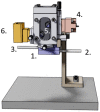Nanomotion Detection-Based Rapid Antibiotic Susceptibility Testing
- PMID: 33801939
- PMCID: PMC7999052
- DOI: 10.3390/antibiotics10030287
Nanomotion Detection-Based Rapid Antibiotic Susceptibility Testing
Abstract
Rapid antibiotic susceptibility testing (AST) could play a major role in fighting multidrug-resistant bacteria. Recently, it was discovered that all living organisms oscillate in the range of nanometers and that these oscillations, referred to as nanomotion, stop as soon the organism dies. This finding led to the development of rapid AST techniques based on the monitoring of these oscillations upon exposure to antibiotics. In this review, we explain the working principle of this novel technique, compare the method with current ASTs, explore its application and give some advice about its implementation. As an illustrative example, we present the application of the technique to the slowly growing and pathogenic Bordetella pertussis bacteria.
Keywords: B. pertussis; atomic force microscopy (AFM); nanomotion; rapid antibiotic susceptibility testing (AST).
Conflict of interest statement
The authors declare no conflict of interest.
Figures




Similar articles
-
Nanomotion Detection Method for Testing Antibiotic Resistance and Susceptibility of Slow-Growing Bacteria.Small. 2018 Jan;14(4). doi: 10.1002/smll.201702671. Epub 2017 Dec 4. Small. 2018. PMID: 29205867
-
Nanomotion Spectroscopy as a New Approach to Characterize Bacterial Virulence.Microorganisms. 2021 Jul 21;9(8):1545. doi: 10.3390/microorganisms9081545. Microorganisms. 2021. PMID: 34442624 Free PMC article.
-
Simple optical nanomotion method for single-bacterium viability and antibiotic response testing.Proc Natl Acad Sci U S A. 2023 May 2;120(18):e2221284120. doi: 10.1073/pnas.2221284120. Epub 2023 Apr 24. Proc Natl Acad Sci U S A. 2023. PMID: 37094120 Free PMC article.
-
Nanomotion detection based on atomic force microscopy cantilevers.Cell Surf. 2019 Mar 8;5:100021. doi: 10.1016/j.tcsw.2019.100021. eCollection 2019 Dec. Cell Surf. 2019. PMID: 32743137 Free PMC article. Review.
-
Living Sample Viability Measurement Methods from Traditional Assays to Nanomotion.Biosensors (Basel). 2022 Jun 24;12(7):453. doi: 10.3390/bios12070453. Biosensors (Basel). 2022. PMID: 35884256 Free PMC article. Review.
Cited by
-
Current and Future Technologies for the Detection of Antibiotic-Resistant Bacteria.Diagnostics (Basel). 2023 Oct 18;13(20):3246. doi: 10.3390/diagnostics13203246. Diagnostics (Basel). 2023. PMID: 37892067 Free PMC article. Review.
-
An Optical Fiber-Based Nanomotion Sensor for Rapid Antibiotic and Antifungal Susceptibility Tests.Nano Lett. 2024 Mar 13;24(10):2980-2988. doi: 10.1021/acs.nanolett.3c03781. Epub 2024 Feb 4. Nano Lett. 2024. PMID: 38311846 Free PMC article.
-
Real-time evaluation of macozinone activity against Mycobacterium tuberculosis through bacterial nanomotion analysis.Antimicrob Agents Chemother. 2025 Jan 31;69(1):e0131824. doi: 10.1128/aac.01318-24. Epub 2024 Nov 27. Antimicrob Agents Chemother. 2025. PMID: 39601550 Free PMC article.
-
Performance of a Machine Learning-Based Methicillin Resistance of Staphylococcus aureus Identification System Using MALDI-TOF MS and Comparison of the Accuracy according to SCCmec Types.Microorganisms. 2022 Sep 25;10(10):1903. doi: 10.3390/microorganisms10101903. Microorganisms. 2022. PMID: 36296180 Free PMC article.
-
Rapid determination of antibiotic susceptibility of clinical isolates of Escherichia coli by SYBR green I/Propidium iodide assay.Sci Rep. 2024 Aug 13;14(1):18782. doi: 10.1038/s41598-024-69286-7. Sci Rep. 2024. PMID: 39138327 Free PMC article.
References
-
- WHO . Antimicrobial Resistance: Global Report on Surveillance 2014. World Health Organization; Geneva, Switzerland: 2016.
Publication types
Grants and funding
- 200021-144321, 407240-167137, CRSII5_173863, 310030L_197946/Schweizerischer Nationalfonds zur Förderung der Wissenschaftlichen Forschung
- AUGE/13/19, I002620N, G068121N/Fonds Wetenschappelijk Onderzoek
- PRODEX Yeast Nanomotion/European Space Agency
- NNH16ZDA001N-CLDTCH/NASA/NASA/United States
- PICT 2017-2444/Agency for Promotion of Science and Technology of Argentina
LinkOut - more resources
Full Text Sources
Other Literature Sources
Molecular Biology Databases
Research Materials
Miscellaneous

